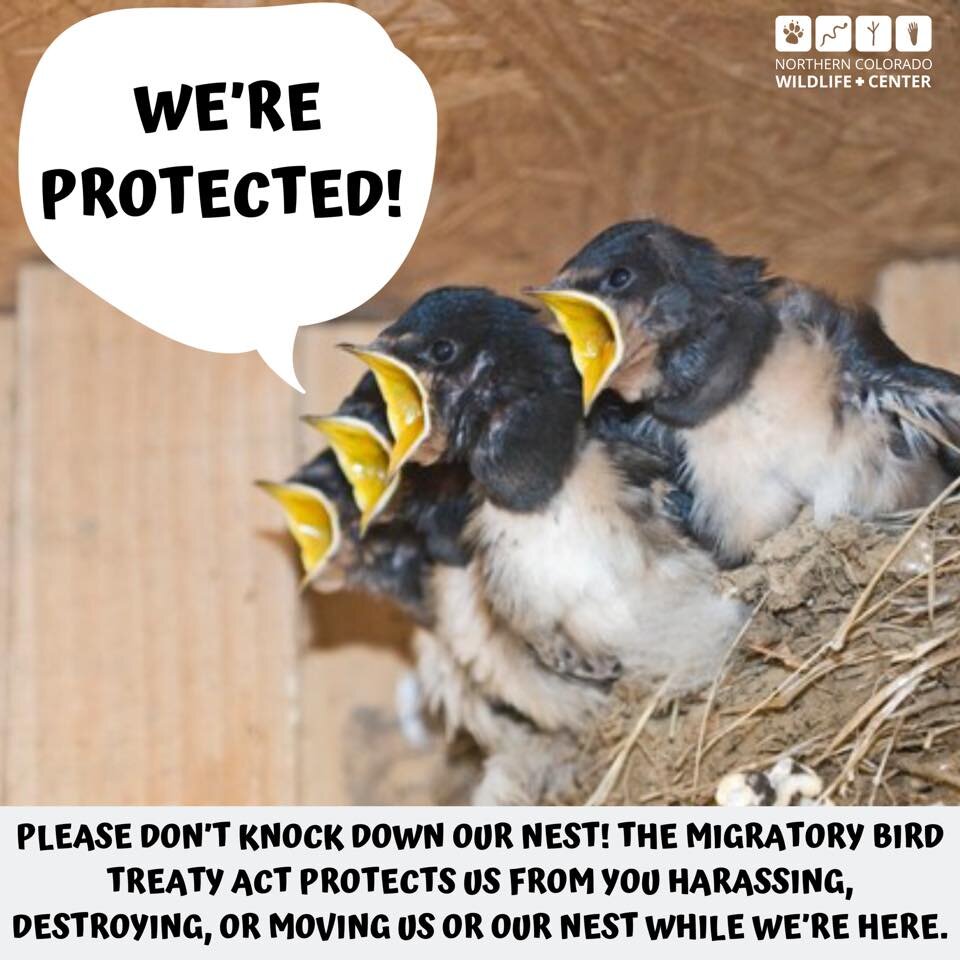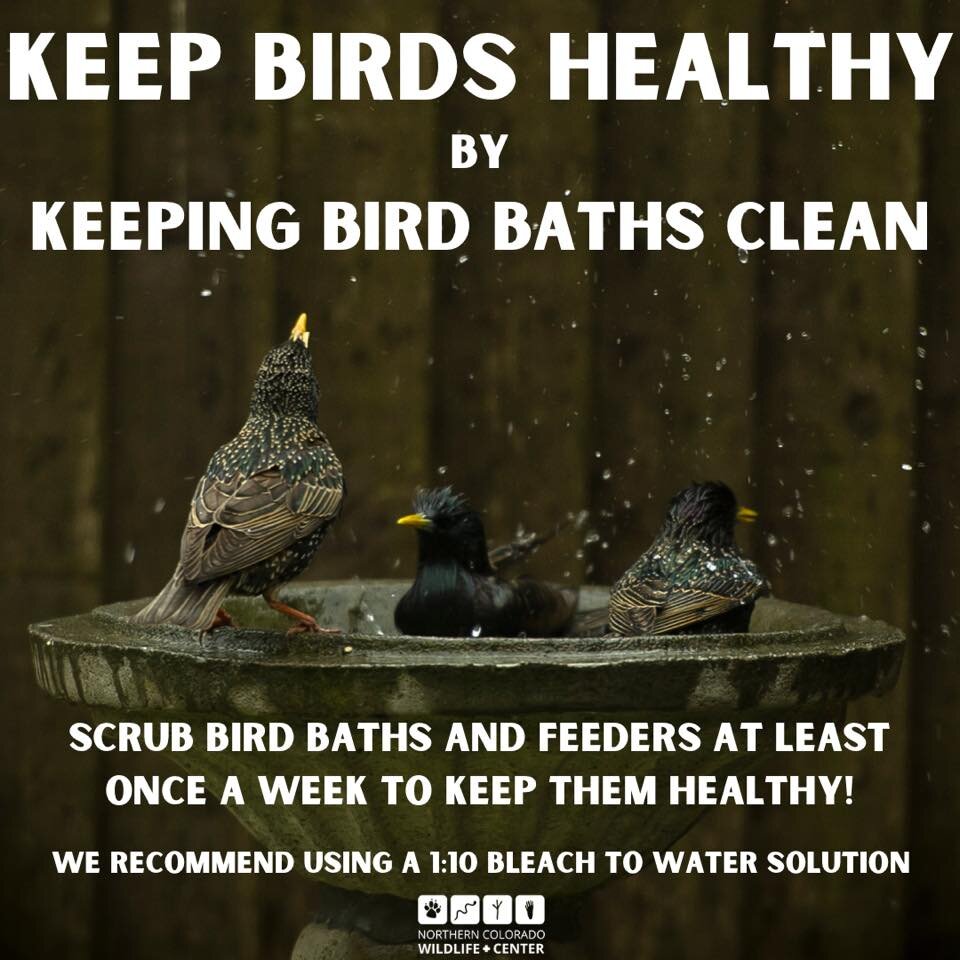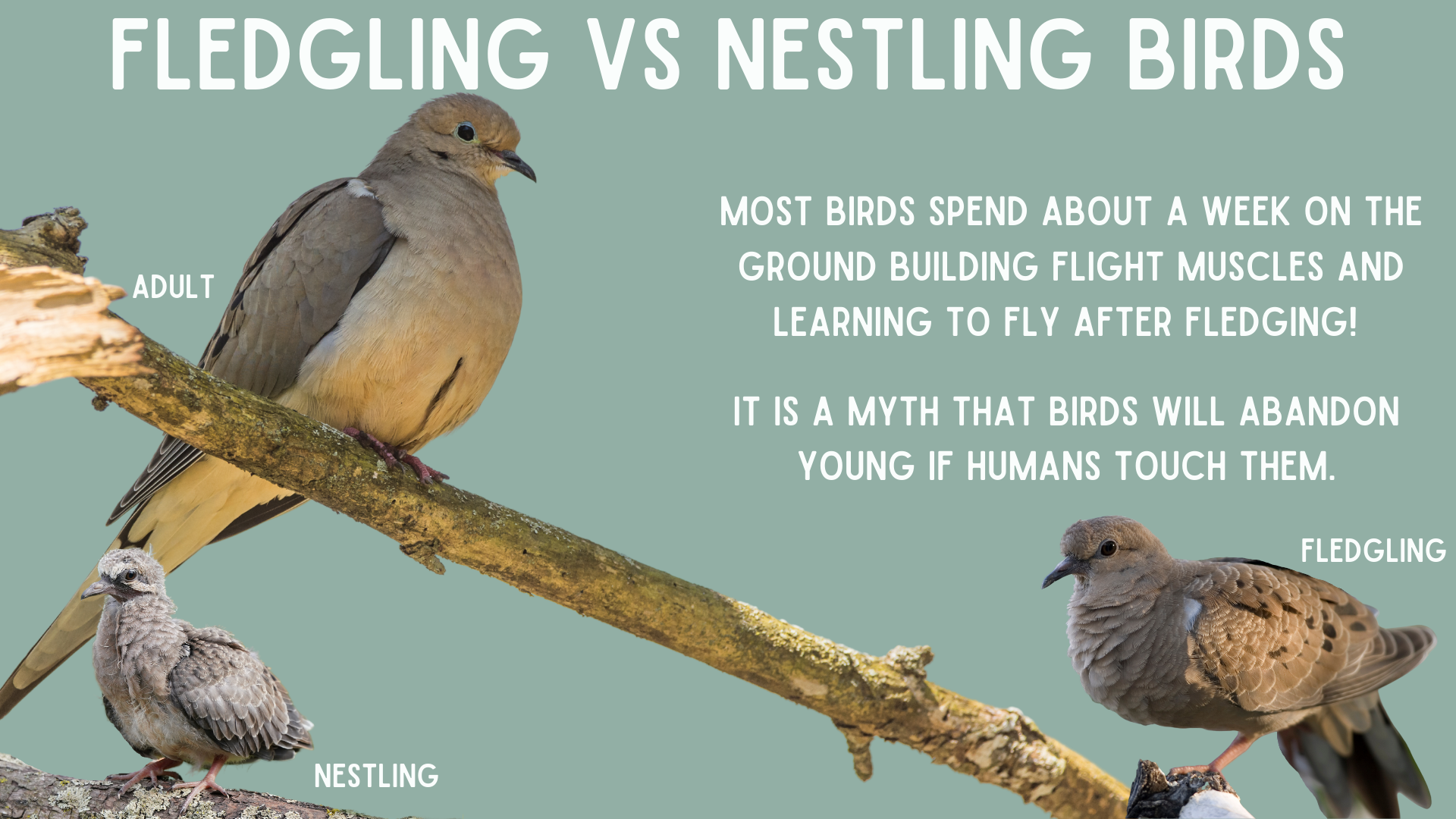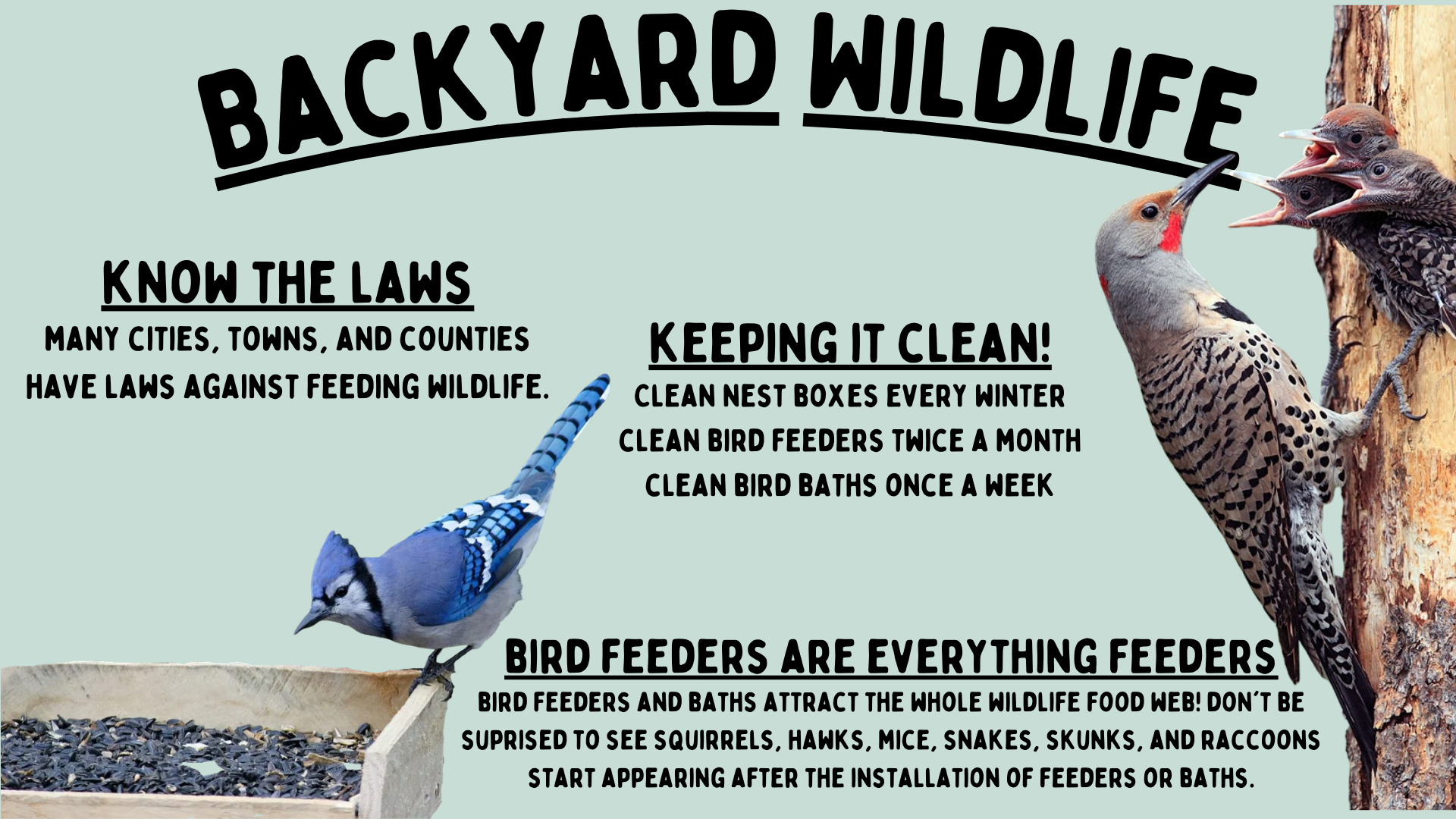Songbird and Other Small Bird Education
Look Before You Cut
Wildlife nest internally and externally in trees. It is important to check each branch and each cavity of a tree for bird and mammal nests before cutting it down. These nests are often protected under state and federal law, so you may have to wait till all babies fledge the nest before being able to cut it down. Winter is a good time for tree cutting.
Don’t Feed Baby Birds
Would you feed these baby birds if you found them in need of help? Hopefully the answer is no. Often times, the most compassionate people cause the worse injuries because they try and feed baby wildlife they find. They often feed the wrong diet, with the wrong utensils, at the wrong increments of time. This causes injuries such as throat lacerations, diarrhea, gastrointestinal paralysis, vomiting, poor feather or fur quality, aspiration, ruptured crops, asphyxiation, pneumonia, or burns. Please don’t feed baby wildlife you find. The best thing you can do for them is to get them to a licensed wildlife rehabilitator.
Swallow Nests
Swallows, like most other birds, are protected under the Migratory Bird Act of 1918. This federally protects them and their nests from being moved, destroyed, harassed, or taken. Please just be patient and coexist with them! They would say thank you if they could!
Fledgling Season
While hummingbirds and aerial insectivores fledge flighted from the nest, many songbirds must spend 5 to 7 days on the ground while they build up their muscles and learn how to fly. Fledglings are very vulnerable during this time, but you can help them by keeping cats indoors or supervised while outside, walking yards before performing maintenance, and covering window wells.
Caprimulgiformes
Nighthawks and Poorwills are two species that belong to the Caprimulgiformes family. They work at night and open their large mouth to swallow large amounts of insects as they fly. Being nocturnal, they sleep during the day and go into a state of inactivity called Torpor. If you see a nighthawk or poorwill sleeping on your deck or porch or in a tree, make sure to give it its space so that it can rest up. They will usually fly away as the sun begins to set in the evening.
Golf Balls Are Cannon Balls to Wildlife
Accidents happen which is why we have to use every opportunity we have to coexist and cut back on our negative impacts on wildlife.
Every year wildlife rehabilitators get in animals that have been hit by golf balls. While these patients are typically waterfowl, other animals such as doves, squirrels, and foxes have been hit before. For humans it hurts to get hit by a golf ball, but for wildlife it can cause life threatening fractures and brain trauma.
When golfing, keep surrounding wildlife in mind before you swing and do your best to keep balls out of trees and ponds.
Keeping Bird Baths Clean
Bird baths can provide wildlife precious water during days of extreme heat or cold, however, they must be cleaned regularly in order for them to remain safe for wildlife. Uncleaned bird baths harbor diseases and parasites that can spread rapidly through a neighborhood’s bird population. Bird baths should be cleaned at least once a week with a 1:10 bleach to water ratio. Scrub the bird bath thoroughly and rinse it several times before putting it back into use.
How to Help a Window Strike Bird
A lot of times birds are just stunned when they fly into windows and just need an hour or two to get their bearings. All they need from you is your help keeping them in a safe, quiet, and solitary space while they do that. If you see them having difficulty breathing or another obvious injury such as asymmetric wings, blood, or deformities, jump straight to step 4 and get them to a licensed wildlife rehabilitation team ASAP! If you have any questions about this process, contact your local licensed wildlife rehabilitator.
Love is in the Air
In the spring, licensed wildlife rehabilitators across the country begin receiving plenty of furry and feathered babies. The easiest way to solve a human-wildlife conflict is to prevent it before it ever occurs so the winter is the time to get rid of unwanted nests if they absolutely can’t stay to help raise another wild family. It is also important to note that most bird species in Colorado are federally protected which means that once a bird establishes a nest with eggs or babies, it is there to stay until they grow up and fledge away.
Northern Flickers
Northern flickers are some of the most common woodpeckers in Northern Colorado and will drill on houses, trees, and the ground while hunting for insects. Flickers will also drill to attract mates which is why we sometimes see them pounding on street lamps. The metal amplifies the sound and allows for more potential mates to hear the charming sounds of a beak against metal. Flickers are cavity nesting birds and each year licensed wildlife rehabilitators receive orphaned babies who have had trees with their nests cut down because they weren’t visible from the exterior. Before you cut any vegetation, make sure to check for nests in every nook and cranny. You never know whose family you could be saving!
Colonies
Several species of swallows nest in Colorado. Swallows are aerial insectivores meaning they dive and bank to catch bugs in the air. These small birds return from migration as soon as the insects are back so expect to see them around spring. Swallows nest together in what are called colonies. These colonies are federally protected under the Migratory Bird Treaty Act meaning that destroying these nests or taking babies from them is a felony.
Black-capped Chickadees
Black-capped chickadees are a common sight in the mountain habitats, but can also be found in urban and rural settings, especially if there are bird feeders. These small birds only weigh between 9 to 14 grams, but what they lake in size, they make up for in intelligence. Chickadees make it through winter by trapping warm air between their feather layers, sheltering in cavities of trees, and relying on food caches that they have built up throughout the fall. Their little brains will even swell to increase their memory and allow them to remember where they have cached food! You can help keep chickadees safe by keeping cats indoors or supervised while outside, hanging anti-bird strike decals in your windows, and deep cleaning bird baths at least once a week!
How to Hold a Song Bird
When you find a songbird that is experiencing an emergency, a licensed wildlife rehabilitator may ask you to place it in a box and transport it to them for extended care. This can be intimidating if you’ve never handled a bird, so here are some tips to ensure your restraint is safe for you and the bird patient. It basically comes down to supporting the birds entire body in a natural resting position, while also having gentle control of the wings and feet so that it doesn’t get away from you. This can be accomplished by cupping your hands around the bird and creating a cavity that acts as a cage. Then you can pick it up and put it in the container that has a secure lid on it. It is important to not bend wings, feet, or the head in unnatural directions as this can cause further injuries such as fractures. Wear gloves if you have them and wash your hands and clothing after handling wildlife. It is important to note that restraining raptors and waterfowl is different and often requires thick gloves, eye protection, and special tactics. In some areas, specialized wildlife rescue teams can come out and rescue these species so that you don’t have to take any risks. In these cases, you help save the bird’s life just by telling the right people the animal needs help.
Fledgling vs Nestling Birds
Fledgling and nestling birds of the same species are usually pretty easy to tell apart. Fledgling baby birds typically look like miniature adults of their species, just smaller and more dull in coloration. Nestling baby birds have pin feathers and possibly small, string like feathers around the head. Nestlings also have difficulty standing on their own and may be extremely naïve when approached by humans.
Backyard Wildlife
Wildlife are one of the best additions to a neighborhood or open space, but we must make sure they are protected if we want to keep their company around. To accomplish this, it is important to understand how to coexist with them around your house. While bird feeders, bird baths, and bird houses can be helpful, some cities do not allow them. These can also be dangerous to wildlife if they become dirty so clean bird baths and feeders at least once a week when in use, and bird houses at least once a year when they are not in use.














